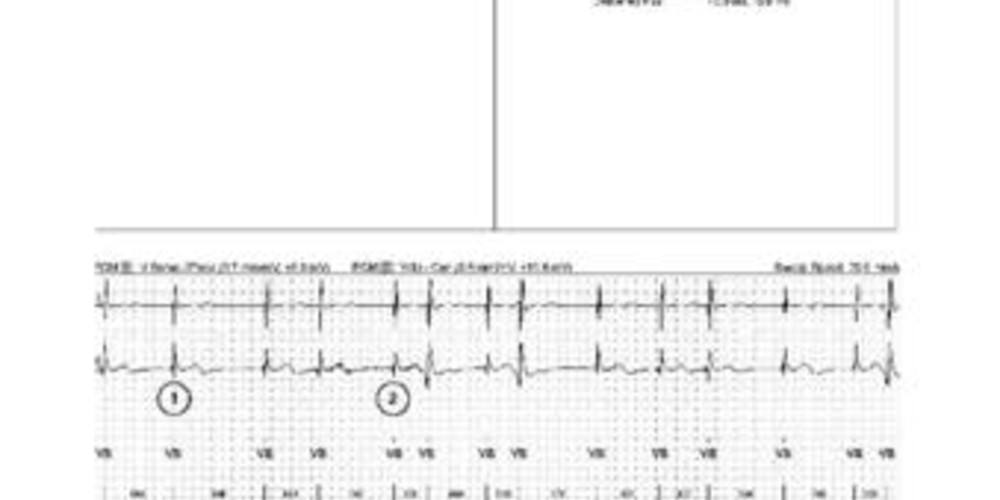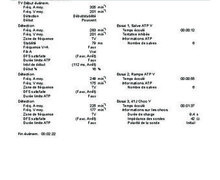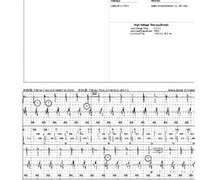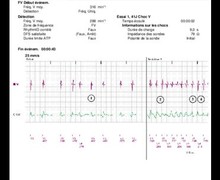Electrical shock for ventricular fibrillation
Tracing
Manufacturer Abbott
Device ICD
Field Therapy
N° 25
Patient
This 64-year-old man presenting with ischemic cardiomyopathy and permanent atrial fibrillation (AF) underwent implantation of an ICD for secondary prevention after an episode of aborted sudden death. He was seen in consultation after a presyncopal episode and an electrical shock.
Main programmed parameters
- Single VF zone at 207 bpm
- 12 cycles in the VF zone were needed for the diagnosis
- Sensitivity programmed at 0.5 mV
- First shock at 15 J, followed by five 36-J shocks (maximum energy)
- VVI pacing mode at 40 bpm; VVI post-shock pacing mode at 50 bpm

Graph and trace
Tracing
- Spontaneous rhythm (VS);
- The patient is in AF with frequent, monomorphic ventricular extrasystoles (VES), at a relatively fixed coupling interval of 320 ms;
- Another VES of the same morphology and coupling interval, triggering a rapid polymorphic tachyarrhythmia. The first cycles are unclassified (while the interval is in the VF zone, it is non-concordant with the average of the preceding cycles, which are still in the sinus zone);
- VVI episode pacing mode (same as the programmed permanent mode) after 4 F cycles;
- VF episode detected by the device (after 12 F cycles) triggering the electrograms (EGM) recording and onset of the capacitors charge (*);
- End of the capacitors charge to 15 J, which lasted 3.6 sec. The 6 short cycles needed to confirm the arrhythmia were detected during the charge (F underscored);
- Confirmation at the end of the charge. The charge was completed; at least 6 short cycles were detected since its onset. The shock was not delivered on the cycle following the end of charge, but was delivered on a cycle, the instantaneous and mean intervals of which were not in the sinus zone;
- Electrical shock synchronized to the second cycle (in the VF zone) following the end of the charge;
- Successful shock and termination of the ventricular arrhythmia; the episode lasted 6 to 7 sec. Probable termination of an atrial arrhythmia and restoration of sinus rhythm (regular ventricular rhythm); return to sinus rhythm diagnosed by the device. This diagnosis by the device does not mean that the rhythm is necessarily sinus (instead of AF for example), but it does mean that the ventricular rate is slower than the slowest rate programmed in the tachycardia zone(s); the post-shock pacing mode is VVI for 30 sec.
Other articles that may be of interest to you







This tracing illustrates the key tasks of ICD, namely the detection of VF and its therapy by an electrical shock. A series of defibrillation shocks were programmed in the VF zone. The strength of the first shock is programmed either at the highest value capable by the device, or at a 10-J lower value, or at a yet lower value that was tested during a VF induction procedure. In this patient, the strength of the first shock was programmed at 15 J, which was confirmed to be successful when 2 consecutive episodes of VF were induced at the end of the implantation procedure. The following shocks were programmed to be delivered at the maximum strength.